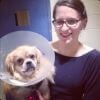Large animal models in translational retinal research
Webinar| June 19| Noon - 1:30pm ET
- Member/Member-in-training price — $0
- Nonmember/Nonmember-in-training price — $15
Audience: Vision scientists, researchers interested in using large animals in translational retinal research.
Summary: The use of animal models is vital in retinal research, including the better understanding of disease mechanisms as well as the development and pre-clinical testing of novel therapies. A wide variety of animal models are used in retinal research, but mice and rats form the majority. Although rodent models have greatly improved our understanding of the pathogenesis of human retinal diseases and have proven to be useful for discovering targets for therapeutic drugs, they sometimes do not mimic the human disorders completely. In contrast, major advances in this area have been made in recent years when using large animal models such as monkeys, dogs, cats and pigs. In this Workshop, which is organized by the ARVO Animals in Research Committee, the audience will be updated on the application and translational aspects of the use of large animal models in retinal research.
This webinar is hosted by ARVO's Animals in Research Committee (ARC). A certificate of attendance will be available to attendees upon request (email education@arvo.org).
Organizers: Meredith Gregory-Ksander, PhD; Christophe P. Ribelayga, PhD; Yutao Liu, PhD; Rupesh Singh, PhD.
Presentations
Canine models of inner and outer retinal disorders – a brief overview
 Andras Komaromy, DVM, PHD (Michigan State University)
Andras Komaromy, DVM, PHD (Michigan State University)
The use of pigs for studying and treating eye disease
 Maureen McCall, PhD (University of Louisville)
Maureen McCall, PhD (University of Louisville)
Companion dogs as translational models of retinal aging and risk factors
 Freya Mowat, DVM, PHD (University of Wisconsin-Madison)
Freya Mowat, DVM, PHD (University of Wisconsin-Madison)
Retinal circuits in health and disease: Insights from non-human primate models
 Teresa Puthussery, OD, PHD (University of California-Berkeley)
Teresa Puthussery, OD, PHD (University of California-Berkeley)
Use of cat and dog models with spontaneous IRDs for development of translational therapies
 Simon Petersen-Jones, DVM, PhD (Michigan State University)
Simon Petersen-Jones, DVM, PhD (Michigan State University)
*Presenters and presentations are subject to change.
